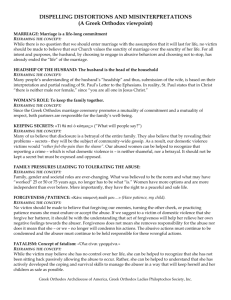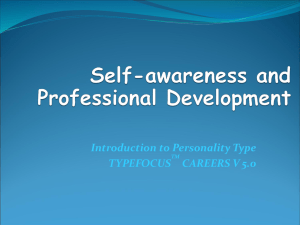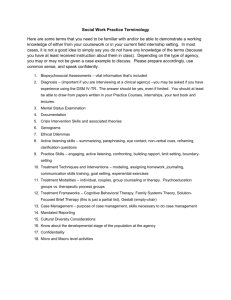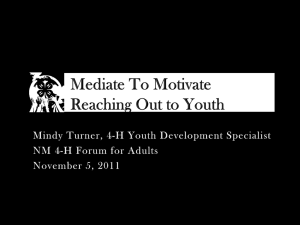change - abrapa
advertisement
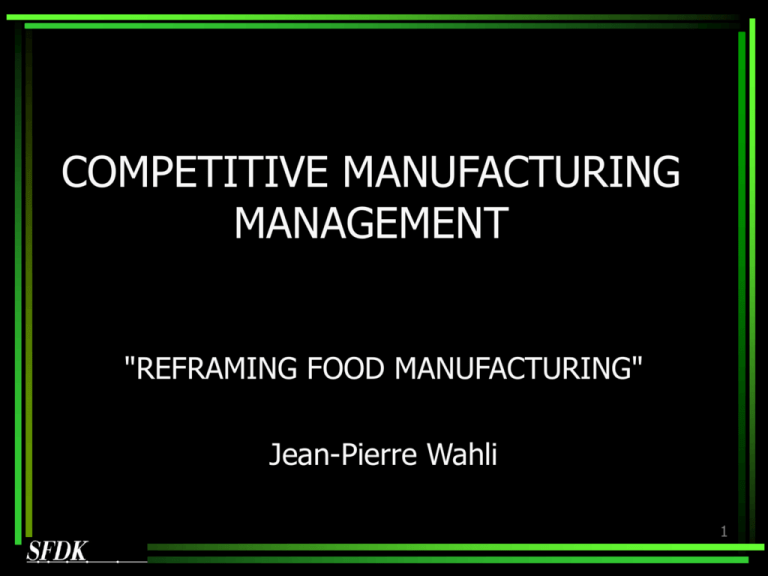
COMPETITIVE MANUFACTURING MANAGEMENT "REFRAMING FOOD MANUFACTURING" Jean-Pierre Wahli 1 MUDANDO PARADIGMAS Uma dupla mudança M O D O NOVA ABORDAGEM ABORDAGEM NOVA D E P E N S A R ABORDAGEM ATUAL Dupla Mudança de Paradigmas REALIDADE ATUAL REALIDADE NOVA NATUREZA DA REALIDADE 2 FALA AGE PENSA SENTE 3 PRINCIPAIS REFERÊNCIAS Teoria da Mudança Watzlawick Gen. System Theory Von Bertalanffy Cibernética Wiener Teoria dos Grupos Galois Teoria dos Tipos Lógicos Russel & Whitehead 4 A FÁBRICA DA “FANTASIA” 5 Estrutura: A estrutura hierárquica tradicional substituída por: - Estrutura auto-adaptável em 3 níveis lógicos - Níveis de supervisão deixam de existir Pessoas: - Altamente comprometidas com a empresa e com a qualidade de seu trabalho - Polivalentes, continuamente treinadas, atuam de maneira independente e trabalham em grupos autônomos - Comportam-se como cidadãos da empresa Processos: - Profundamente compreendidos e totalmente sob controle - Não há interrupções no processo produtivo - Praticamente não existem desvios de qualidade 6 Qualidade: - O objetivo é a consistência da qualidade - Qualidade dos processos - Ausência de laboratório para produtos acabados e matérias primas Custos: - Reduzidos em valores muito além das economias produzidas pelas mudanças estruturais - Melhoria Contínua é um processo orgânico Fornecedores: - Integrados profundamente com a empresa - Muitos tornam-se parceiros dos negócios - Sistema QA devidamente certificado, permitindo entregas JIT, sem riscos 7 Meio Ambiente: - Plena consciência das economias para a empresa e benefícios para o meio ambiente, com a eliminação de desperdícios e poluição Know-how: - Crescimento e competitividade baseados no aprendizado e no conhecimento - “Learning faster than the competition is the only sustainable competitive advantage” 8 E PUR, SI MUOVE… Este modelo foi implantado em 27 fábricas no Brasil Considerado “best in class” em todos os exercícios de benchmarking envolvendo as fábricas do Grupo no mundo Transformou-se em modelo a ser seguido dentro das fábricas do Grupo 9 CYBERNETICS The study of communication and control in living systems Aimed at the development of thinking machines Used animals and humans as a model A multi-disciplinary team: physicists, engineers biologists, physiologists, neurologists pedagogues, psychiatrists, anthropologists … Created the concept of FEEDBACK which enables to deal with unpredictable events 10 CYBERNETICS The 2nd industrial revolution (the information age) with: - Automation - Information technology - Robotisation Contributed to the evolution of: - Biology - Pedagogy - Neurology - Psychiatry - Etc Removed the barrier between human sciences and exact sciences 11 CHANGE THEORY 2 basic questions in a change process: Why does the undesirable situation persist? What is required to change it? 12 ORGANIZATION OF THINGS Numbers Objects Ideas Concepts Events Etc. paradigm 13 GROUPS Follow the 4 properties of Group Theory Members are all alike in one common characteristic A combination rule between the members Basic axiom: The outcome of the combination of two or more group members is itself a member of the group Other properties: associative 3 + 7 = 10 neutral (identity) member ! 3 x 7 = 21 opposite (reciprocal) member 3+0=3 4x1=4 7 + (-7) = 0 The rule is itself an attribute of the group 14 GROUP THEORY: CONCLUSION Illustrates changes within a system that itself remains invariant The perception of change or persistence depends on the position of the observer The paradox: "Plus çà change, plus c’est la même chose! ” 15 SYSTEMS THEORY Closed mechanical systems with independent parts Y = f (x1, x2, x3, x4, …) Charateristics: - Closed systems - Independent functioning of the parts - Whole = ∑ Parts Principle: - Linear systems - Understandsable with classical mathematic System dysfonction: - Entropy increases 16 SYSTEMS THEORY Open living systems with interdepent parts x1 Y = f x2 x4 x3 Characteristic: - Parts are in interaction Whole ≠ ∑ Parts Principle: - Non-linear information bonded systems - Statistical approach (probabilities) - Positive metabolism = Negentropy Dysfunction: - Counter-intuitiveness 17 SYSTEMS THEORY Information Principle of Cybernetics in living systems: The content of what is exchanged with the outer world as: - one adjusts to it - one makes our adjustment felt upon it Not subject to the law of conservation Not lost by sharing it with others Entropy is the measure of disorganisation Information is the measure of organisation I=-S 18 SYSTEMS THEORY Counter-intuitiveness Properties of complex systems: Cause & effect separated in time and space Cause and effect can replace each other Multiple effects (order of importance shifts in time) Removing causes does not remove effects System destabilized if parts change importance Turns solutions into problems by increasing disorder, thus entropy From a Predator/Prey model to Competition one 19 SYSTEMS THEORY The nod of the question Organization are non-linear systems x1 Y = f (x x21, x2, x3, x4, …)x4 x Representations or models are linear systems 3 Representations/models only valid in a stable environment! In an unstable environment, using the model for change : - Complex systems display counter-intuitive effects! - Change to maintain the equilibrium of system is a constant - Internal conflicts & disorder: "entropy" increases The paradox: "It was better when we were worse! ” 20 PRISONERS OF THE SYSTEM 21 22 23 24 Problem is: Not the impossibilty of the task, but the attempted solutions The result of a self-imposed condition Solution found by: Assumptions about the dots At the next upper logical level A change from a set of premises to another of the same logical type Change is only possible at that level It is the logical way out of the system Pawns of a game x player 25 ORGANIZATION OF THE THINGS 2nd order/level Type 1 Attribute 1st order/level Type 0 Object 26 THE THEORY OF LOGICAL TYPES 3rd order/level Light Type 1 Attribute 2nd order/level 1st order/level Type 2 Property of the attribute Disc Type 0 Object 27 THE THEORY OF LOGICAL TYPES Purpose: To avoid paradoxes of the Group Theory when analysing complex systems Focuses on: - the relationship between members & class - the metamorphosis in shifts from one logical level to the next higher Axiom: "Whatever involves all of a collection must not be one of the collection" 28 THE THEORY OF LOGICAL TYPES To avoid paradox engendering situations: Logical levels to be kept strictly apart Members and class shall not be mixed up The next higher logical level contains all the attributes (properties) of the members Going to the next higher logical allows to exchange attributes of a same logical type 29 CHANGE THEORY Two types of changes: “First order change” Occurs within a given system which itself remains unchanged in its nature “Second order change” The other whose occurrence changes the nature of the system itself 30 CHANGE THEORY First order change Follows the properties of the Group Theory Based on « logic » & common sense Looks safe, pragmatic, reassuring Seeks solutions within the system It is the domain of the obvious The system remains invariant The paradox: "Plus çà change, plus c'est la même chose…” "It was better, when we were worth!” 31 CHANGE THEORY Second order change Based on the theory of Logical Types Applies to 1st order solution It is a discontinuity, a logical jump Always involves the upper logical level The logical way to think "out of the box" Deals with the effects and not their causes Asks the question what? and not why? Puts a situation in another frame / context System to be kept flexible (self-adaptation) 32 COMPARING BOTH TYPES OF CHANGES 1st order change 2nd order change • Considers practical value of things (pragmatism) • Considers perception/ signification of things • Fragmental approach • Technical knowledge • Systemic approach • Intelligence, logic • Complicated & complicating • Complex & simplifying • Changes the process • Changes the system KISS approach: Keep It Simple, Stupid Keep It Simple, Smart Both types of changes are Compatible & Complementary 33 System: Positive and negative integers, including zero. Internal rule: Multiplication 2nd order change Internal rule: Addition Neutral element: Neutral element: Composition with n : Composition with n : 1 n.1=n 0≠1 n+1 34 THE DUAL PARADIGM SHIFT SYSTEMIC APPROACH N A T U R E O F I N Q U I R Y INTERDEPENDENT VARIABLES Wholes are structurally divisible but functionally indivisible Deals with interactions between the parts, 2ndthe ORDER CHANGE the partsAVOIDING with the whole and its environment PROBLEMS ∑ parts = nonsense (non-linearity) CREATING OPPORTUNITIES Macromanaging interaction (power to do) INTERACTIVE Understanding the system INQUIRY ANALYTICAL APPROACH INDEPENDENT VARIABLES DUAL SHIFT OF PARADIGM Reduces complex wholes to simple ones Deals with variables separately, aggregate the 1ndthe ORDER CHANGE understanding of the PROBLEMS parts into understanding of the whole CREATING ∑ optimised parts = optimised whole MISSINGaction OPPORTUNITIES Micromanaging (power over) Knowledge of how the system works LINEAR SYSTEM NATURE OF ORGANIZATION NON LINEAR COMPLEX SYSTEM 35 Aoccdrnig to a rscheearch at an Elingsh uinervtisy, it deosn't mttaer in waht oredr the ltteers in a wrod are. The olny iprmoatnt tihng is that frist and lsat ltteer is at the rghit pclae. The rset can be a toatl mses and you can sitll raed it wouthit porbelm. Tihs is bcuseae we do not raed ervey lteter by itslef but the wrod as a wlohe and in its ctnxoet . 36 According to a research at an English university, it doesn't matter in what order the letters in a word are. The only important thing is that first and last letter is at the right place. The rest can be a total mess and you can still read it without problem. This is because we do not read every letter by itself but the word as a whole and in its context. 37 CHANGING THE GAME 38 THE 2nd ORDER CHANGE 2nd ORDER 1st ORDER CURRENT PRINCIPLES OF LIFE 2nd order change CURRENT RULES & REFERENCES Current system behaviour NEW PRINCIPLES OF LIFE REFORMULATION OF OPERATIONAL CONCEPTS Expected system behaviour 39 “REFRAMING” - Changes the conceptual setting of a situation - Put it into another frame or context New frame must: - fit equally well or better the “facts” of the same concrete situation - change its entire meaning Once a new association is perceived: - no return to the former vision 40 “REFRAMING” 2nd order 1st order 41 THE 3 SINS OF CHANGES Ignoring the logical structure of complexity Not keeping the logical levels apart Attempting the change at the wrong level 42 THE LOGIC OF THE MADNESS 43 REFRAMING A MANUFACTURING COMPANY Let's put cybernetics into management! Reframing the organisational principles Reframing homo sapiens Reframing the rule of labour relations Reframing the structure Reframing the policy deployment Reframing the notion of quality Reframing continuous improvement The door now is open for countless subsequent reframing…! 44 WHAT'S ARE THE TANGIBLE BENEFITS ? DISCOVERING THE HIDDEN FACTORY 45 stop harrasment We want CMM 46 THE HIDDEN FACTORY: Most of the problems which occur on the factory floor have their origin out of it They are problems linked to interactions: - communication - norms - administration To management style as a whole 47 Hidden problems: Deficient communication Obsolete or inappropriate norms Inadequate changes Problems poorly solved Technology poorly implemented Not adapted working place Inappropriate materials and tools Improvised innovations Insufficient training Bad planning Etc… The hidden factory 48 VALUE CREATION IN MANUFACTURING Opportunities Real Potential Reduction of structural cost & Reframing the premises of the organisation & Discovering the “hidden” factory Registered Time 49 VALUE CREATION IN MANUFACTURING Opportunities Real Potential REAL Value creation REGISTERED The “hidden” factory Registered Time 50 HOW TO DO IT? 51 52 WHAT'S ARE THE TANGIBLE BENEFITS ? HOW TO DO IT? 53 54 PERCEPTION OF A COMPANY A company is a set of resources containing (equipment, technology, know-how, people, etc.) organized and managed in function of a given business The efficient utilization and combination of these resources is crucial for the success of the organization 55 WHAT IS AN ORGANIZATION ? An organization is a group of people who purposefully thinks, acts and interacts, aiming at a common objective The differential of performance between organizations will fundamentally depend on how their members think, act and interact 56 WHAT IS AN ORGANIZATION ? A new organization requires understanding of: Principle of Cybernetics : organizational life only so far as(whole) A- community extends - individual (parts) there extendsbehaviours an effectual transmission of information - interpersonal relations (interactions) 2nd paradigm shift To allow: - the reformulation of operational concepts In order to: Make leaders and leds true partners 57 CHANGE OF THE GAME N A T U R E O F I N Q U I R Y SYSTEM APPROACH INTERDEPENDENT VARIABLES ANALYTICAL APPROACH INDEPENDENT VARIABLES DUAL SHIFT OF PARADIGM SOCIOORDER CHANGE CULTURAL AVOIDING PROBLEMS MODEL 2nd CREATING OPPORTUNITIES INTERACTIVE MGMT SOCIO- 1nd ORDER CHANGE TECHNICAL CREATING PROBLEMS MODEL MISSING OPPORTUNITIES PARTICIPATIVE MGMT MECHANICAL MODEL UNININDED SYSTEM SOCIAL MODEL MULTIMINDED SYSTEM NATURE OF ORGANIZATION 58 THE SOCIO-CULTURAL SYSTEM The 2nd paradigm shift Universe of symbols The system is information and value bonded Performance relies on the quality of information Multiminded Purposeful members with choice of ends and mean Multidimensional Neither tendency A nor B, but tendency A and B Emergent properties All-stars team is not necessary the best in the league Not one-time propositions 59 HOW EMPLOYEES ARE PERCIEVED Resources driven by own needs Exchange working hours for salary They shall do “more and more in less time” with: - passive obedience (Cyborg) - commitment - creative involvement Their nature is highly “ deviant ” and are “ expensive ” They must be “ supervised ” and their “ cost minimized ” Conflicting objectives: - Companies to maximize profit - Employees to maximise labour conditions 60 Principle of cybernetics: "Information is the name of the content which is exchanged with the outer world as we adjust to it, and make our adjustment felt upon it" "Communication and control belongs to the essence of man's inner life, even as they belong to his life in society" HOW HOMO SAPIENS WORKS HOMO UTILUS Resource Price Doesn’t think Heteronymous Dependent Participates SERVANT Practical aspects Utility C 0 N T E X T Competence Talent Skill HOMO SAPIENS Individual Dignity Think Autonomous Independent Commits CITIZEN 62 THE EMPLOYEES CITIZEN WANT Know What is going, who is who, who does what… Objectives, priorities, constraints, problems… Understand The decision process, options, implications… Feel important A role to play and possibilities of choice Opportunities to grow and develop as a person Recognition and respect Contribute Participate in plans for changes Help to build a future in which they believe To live their emotions in their professional role 63 THE HUMAN USE OF HUMAN BEINGS 64 Managing Human resources Basic premises Role of the leader C People are an important asset U Their utilisation must be R maximized Planning R of human resources is critical E Establishes objectives N Evaluates performance Provides adequate T recognition R U L E Challenge How to: - select ? of the - evaluate ? leader - promote ? Managing People’s talent People are not resources They have resources Releasing individual talents is vital for: - employees’ self- satisfaction - success of the organization N E W where Creates an environment people can act at their highest level Channels people's energy Cares them and shows it R U How to: L - support and encourage? - listen and be understood ? E - manage the working place? 65 Group of homo sapiens The clubbing squad Problems Group of homo utilus 66 Group of homo sapiens Resistance Problems The clubbing squad Group of homo utilus 67 BASIC PRINCIPLE OF ORGANISATIONS Axiom of the Logic Type Theory: « The level which contains all the members of an organisation cannot be a member of it » Supervision & control: - create logic types paradoxes, i.e. paradox engendering situations - is a double bind situation - spoils the logic of an organisational structure Control is the essence of a taylorian system It's the "golden veal" of efficiency worshipers 68 THE STRUCTURE IN 3 LOGICAL LEVELS Level III Meta-metalevel Level II Metalevel Level I 69 THE STRUCTURE IN 3 LOGICAL LEVELS Level III Factory Meta-metalevel Level II Metalevel manager Extended management team Level I IMPROVEMENT FUNCTION Ensures learning and continuous improvement. Is long term and process oriented Employees OPERATIONAL FUNCTION Ensures predictable results and the control of the operation. Is short term and result 70 oriented. THE STRUCTURE IN 3 LOGICAL LEVELS Symphonic orchestra Football club Level 1 Musicians Players Priest Level 2 Conductor Manager Bishop Level 3 Composer Club chairman Pope Rule Partition FIFA rules Bible church Catholic 71 POLICY DEPLOYMENT Injecting energy Pact Level III Level II Level I Policy (Ends) Principle of Measures system theory: (Means) COMPATIBILITY of COALITION COOPERATION Principle cybernetics: Policy Measures The more probable the message, the (Ends) MEANS less information(Means) it gives Messages sets of information INCOMPATIBILITYareCONFLICT COMPETITION subject to disorganisation in transit Policy Measures INCOMPATIBILITY (Ends) COMPATIBILITY (Means) ENDS 72 POLICY DEPLOYMENT Channelling the energy Level III Level II Level I Policy (Ends) Measures (Means) Policy (Ends) Measures (Means) Policy (Ends) Measures (Means) 73 CURRENT QUALITY BELIEFS Quality is the responsibility of everyone Quality is product oriented Product release to the market based on statistical analysis Labs to be well equipped with skilled staff However: Low level of confidence If quality is the responsibility of everyone, WHO does WHAT? 74 THE LOGIC OF QUALITY Level 3 Attribute of the attribute Perception of the product quality Level 2 Attribute of the object Product quality Level 1 Object Product 75 QUALITY AND PRODUCTIVTY IN A BUSINESS PERSPECTIVE PRODUCT QUALITY: CONSUMER SATISFACTION Product design QUALITY CONSISTENCY: CONFORMITY WITH THE MODEL No quality deviation PROCESS QUALITY: EFFICIENCY: CERTIFIED PROCESS All CPs & CCPs under control OPTIMIZED PROCESS Best possible performance 76 Process oriented quality provides at the same time: Consumer satisfaction Best possible performance Confidence level above 95% Product analysis not necessary 77 CONTINUOUS IMPROVEMENT CURRENT BELIEF A pragmatic management initiative aiming at performance and cost improvement « Ad hoc » groups dealing with specific problems Aims at tangible objectives Analytical (fragmental) approach. Micro-management Monitoring of cost evolution Stimulated by tangible rewards to groups 78 Principle of non-linear systems: The sum of individual efficiencies does not result in the efficiency of the whole 79 BASIC ASSUMPTIONS Purposeful members do not like: Dysfunctions of equipment and organisation Losses and waste Disorganised working place Objectives above people & equipment capacity All the work-disturbing factors Everything affecting quality of life at the working place 80 CONTINUOUS IMPROVEMENT Is the aim of the Improvement Function Stimulates and supports initiatives that: - improves quality of life at the working place - fights disturbing factors Continuous improvement builds the most exciting place to work in ! 81 CONTINUOUS IMPROVEMENT Is a continuous reframing of the premises of any activity Is an organisational & evolutionary (2nd order) learning For the members: For the organisation: an improvement in the quality of life at the working place an improvement in the organisation’s performance A win-win situation at the 2nd order level 82 83


